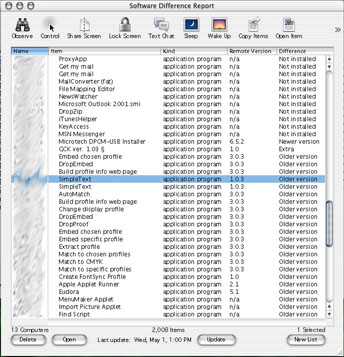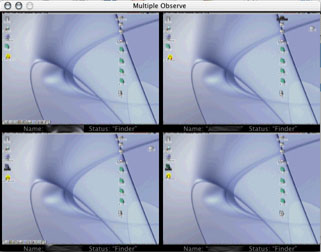Not quite enterprise yet
By Remy Martin, May 2, 2002
Feedback Farm
Have something to say about this article? Let us know below and your post might be the Post of the Month! Please read our Official Rules and Sponsor List.
Forums
Want to dig even deeper? Post to the new MacEdition Forums!
If you are familiar with UNIX, you know that there are plenty of ways for remotely accessing another computer. One simply needs a terminal program with ssh (Secure Shell) capabilities (you can use telnet in a pinch), and you can gain full control of the computer, change settings, and troubleshoot problems as long as you can remember long strings of commands, the location of the various text files to change configurations, and the proper syntax of all these configurations. It sounds daunting, but given appropriate knowledge of each of the systems, it’s actually very manageable when you get the hang of it (and as long as you are paid enough for your trouble).
With Windows, there is a plethora of “enterprise” tools that allow you to mange software from a central location. Symantec Ghost is a popular tool used to manage software rollouts and updates. Symantec’s Norton Antivirus Corporate addition allows an administrator to check the status of virus scans, remotely authorize virus scans and update virus definitions. There are a lot of applications that come in “enterprise” or “corporate” guise which all feature centralized control. All of this magic happens from the comfy confines of your favorite task chair.
I’ve long lamented that the MacOS hasn’t been up to task when it comes to dancing the marengue with the rest of the folks in the enterprise space. A few weeks ago, Apple introduced its Apple Remote Desktop (ARD) product with relatively little fanfare from the press despite all the best efforts of Apple’s legendary (if somewhat selective) PR machine.
To most of the Macintosh populace, Remote Desktop really is something that you can live without. For those of us who have the task of administering a group of Macs, Remote Desktop can be a huge asset to managing a host of Macs, especially with the lack of other tools available to us. Combined with Apple Software Restore, it gives administrators a useful set of tools for managing their Macs.
There seems to be quite a lot of people familiar with the Mac OS and Apple Hardware that haven’t yet discovered the wonder that is Apple Software Restore (ASR), or at least using creating and restoring their own disk images using ASR. Apple Software Restore has been included with Macs for a long time as a way to restore the computer to original factory condition. What many don’t know is that ASR can be used to create your own disk images in preparation for duplication to many computers at a time.
I prefer Apple Software Restore to some other tools out there such as Assimilator, although there are advantages and disadvantages to each. The greatest thing I like about ASR is (with OS 9.1), you could create a disk image that could work with Macs from the lowly 6100 to the almighty G4 given enough disk space. OS 9.2 runs on a smaller range of computers, but the idea is still the same. Although I’m not going into further detail about ASR here, you can find more information on using it for yourself from Apple’s Developer Documents and MacAddict. You really have to tweak it to your own tastes but I use ASR in a variety of ways. If I know that a computer is going to have a minimal installation, it is possible to make a bootable CD with a restore image that can travel anywhere. For disk images that can’t fit on a disk, you can place the image on any network storage, start the Mac up from a CD and go about your business from there. Very useful. And I’ve been promised from a few sources that an OS X compatible ASR version will be released soon.
Now that I have my Macs quickly set up, the main trouble becomes maintenance. Although Apple Software restore is great, making an incremental upgrade to your disk image is not trivial. It requires a large amount of time and you still have to get on your feet and move to each computer that needs to be upgraded. Enter Apple Remote Desktop. Many of you Mac veterans are going to say that Apple Remote Desktop is really nothing more than Apple Network Assistant (from the Apple Network Assistant Toolkit - ANAT) gussied up for OS X, and you would be correct, except there are some key differences. Apple Remote Desktop works for OS X and OS 9 and greatly improves on the stability of ANAT.
Apple Network Assistant was great in theory, but it was very touchy depending on your network setup. Computers would mysteriously become unavailable, even when not in deep sleep, and would require several restarts of the application just to view all of the computers you were allowed to administer. Apple Remote Desktop has largely taken care of this problem. I have no trouble leaving it open all day and I don’t get false “unavailable” messages. What’s more, the performance hit is quite small compared to ANAT. I attribute some of that to OS X, but much of it may be dependent on the new client extension installed on all of the nodes. Apple Remote Desktop is faster on the G3/500 PowerBook than ANAT ever was on a 867 MHz G4.
Now that Apple Remote Desktop answers the stability and performance issues from Apple Network Assistant, I urge a lot of Mac administrators to give it a try. The unlimited license is not that expensive, even for smaller institutions and especially with the education discount, and it will make your day more productive. The client installs on any Mac with OS 8.1 or greater, so most of your userbase should benefit.
Here’s just a few few of the tasks that I use Network Administrator for:
-
Software Reports. I use the software difference reports to keep track of
which updates have been completed on certain computers.
 Although I can’t
perform every upgrade using the copy feature of ARD, it allows me to quickly
identify which computers need to be upgraded if I don’t. If the report
finds software that isn’t authorized on that computer, I can delete the
software right away.
Although I can’t
perform every upgrade using the copy feature of ARD, it allows me to quickly
identify which computers need to be upgraded if I don’t. If the report
finds software that isn’t authorized on that computer, I can delete the
software right away.
- Hardware Reports. Although not quite Apple System Profiler specific, the hardware reports can give you an idea of what you have available when you are planning an upgrade. Network performance reports (a simple ping test) can help troubleshoot network issues.
- Hardware Interaction. Along with hardware reports there is a Hard Disk Report and Disk Verification which runs a check like Disk First Aid and will report and fix errors. You can erase and copy whole disks and sleep, wakeup, restart or shutdown all of your Macs as well as empty the trash and rename the computer.
-
User Interaction. ARD has some of the same ability as ANAT to observe and
control client computers.
 This is primarily geared towards educators (lock
screen anyone?), but in combination with the User Chat feature, is helpful
in a Help Desk setting. If a person calls and is having trouble locating a
dialog in Word or selecting a printer from the chooser, you can guide the
person along. Nifty indeed.
This is primarily geared towards educators (lock
screen anyone?), but in combination with the User Chat feature, is helpful
in a Help Desk setting. If a person calls and is having trouble locating a
dialog in Word or selecting a printer from the chooser, you can guide the
person along. Nifty indeed.
Things are not perfect, of course. Copying is still problematic at times (mainly with multiple nested folders), and I think that it would be wise to enable a remote software update for each computer, or at least enable client to client copying. Right now, files you copy must reside on the administration computer, which sometimes makes it difficult to perform copies. I have created a few partitions that mirror our lab setups, but being able to copy from a lab machine would be nice. But again, since incremental System updates can change a lot of files, it would be nice to enable them remotely. Oddly, ARD doesn’t have much AppleScript support that I can find. I would love the ability to complete certain tasks (like empty trash on all computes, or refresh desktop) with the ease of a double-click, but that is not possible.
Apple Remote Desktop and Apple Software Restore doesn’t answer every question for Apple in the Enterprise Space — like a comprehensive Mac Manager for OS X and OS 9 and a version of NetBoot (that doesn’t require animal sacrifice to run smoothly) might. However, it does offer administrators and managers a way of centralizing certain services and maintenance tasks. The most difficult part is installing it on the computers that need to be managed. It has become a software package I use every day and actually wish I had available for use on other platforms.
